Harris C.M., Piersol A.G. Harris Shock and vibration handbook
Подождите немного. Документ загружается.


29.16 CHAPTER TWENTY-NINE, PART I
with parameters obtained by filling experimental data. The onset of instability is
predicted as
12, 22, 23,31
= C
a
(29.16)
where V
crit
= uniform cross flow averaged over minimum gap between tubes (If the
velocity is nonuniform, then either the maximum can be used or a
modal weighted average can be employed.)
f
n
= fundamental natural frequency of tubing (Ordinarily the fundamen-
tal mode is most susceptible to instability.)
ζ=damping factor of fundamental mode (Typically ζ falls in the range
between 0.01 and 0.03 for tubes with some intermediate supports. For
rolled-in or welded-in tubes with no intermediate supports, ζ can be
as low as 0.001.)
m
t
= mass per unit length of tube including added mass and internal mass
of fluid
ρ=fluid density
Fitting Eq. (29.16) to the available 174 data points for onset of instability
31
shown in
Fig. 29.14 leads to the mean and lower-bound coefficients for the parameter C and
the exponent a given in Table 29.1. The coefficient corresponding to the mean fit to
the experimental data is C
mean
; C
90%
is the lower bound fit to the data such that 90%
of the data are above the curve.
Most of the data used in this correlation come from tube arrays with center-to-
center spacing of between 1.25 and 2.0 diameters and with various array geome-
tries. There is insufficient statistical evidence to determine if certain patterns are
more or less susceptible to instability than others. Instability has been observed for
both straight and curved tubes, tube rows, and tube arrays in a wide variety of tube
patterns.
The most common means of increasing the resistance of an array of tubes to
instability is to add intermediate supports to increase the natural frequency of the
tubes. Details of the tube support (particularly the gap between the tube and the
support) influence the resultant vibration. In general, smaller gaps tend to result in
lower tube-support impact velocities and hence in lower tube wear.
32,33
INTERNAL FLOW IN PIPES
Internal flow through a pipe decreases the natural frequency of the pipe. Sufficiently
high internal velocity will induce buckling in a pipe supported at both ends since the
momentum of fluid turning through a small angle of pipe deflection is greater than
the stiffness of the pipe. If the pipe is restrained at only one end, the pipe will
become unstable at high velocities like an unrestrained garden hose.
The equation of motion for a straight pipe conveying steady fluid flow is
34,35
EI +ρAv
2
+ 2ρAv + M = 0 (29.17)
where E and I are the modulus and moment of inertia of the pipe which conveys
fluid of density ρ through the internal area A of the pipe at a steady velocity v;
Y(x, t) is the lateral deflection of the pipe which has total mass per unit length M.
∂
2
Y
∂t
2
∂
2
Y
∂x∂t
∂
2
Y
∂x
2
∂
4
Y
∂x
4
m
t
(2πζ)
ρD
2
V
crit
f
n
D
8434_Harris_29_b.qxd 09/20/2001 11:44 AM Page 29.16
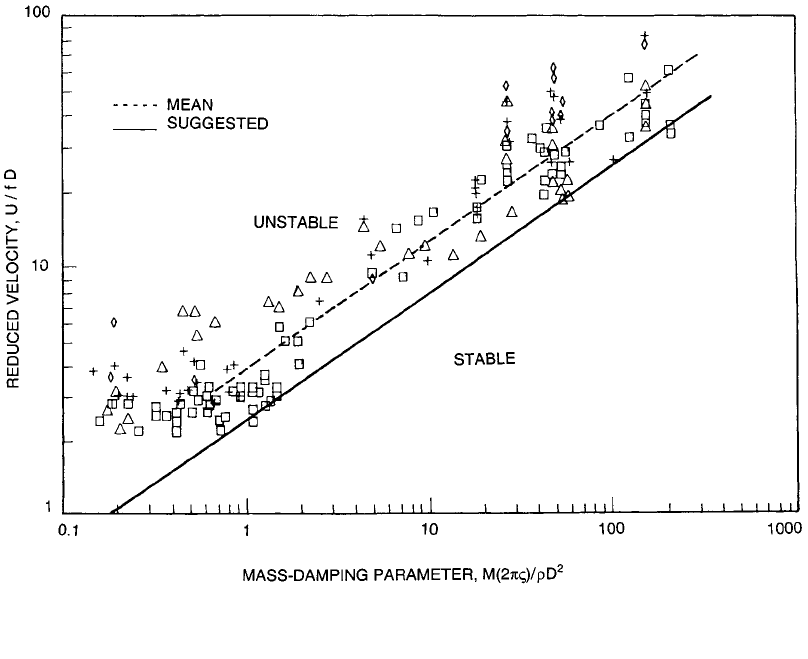
FIGURE 29.14 Velocity for onset of instability of tube arrays in cross flow as a function of the damping parameter
.
22
29.17
8434_Harris_29_b.qxd 09/20/2001 11:44 AM Page 29.17

The first and last terms in Eq. (29.17) are the usual stiffness and mass terms.The mid-
dle terms are associated with fluid forces imposed on the pipe by the internal fluid
as the pipe deflects slightly from its equilibrium position.
Although Eq. (29.17) is a linear partial differential equation with constant coeffi-
cients, its solution is difficult owing to the mixed derivative term (third term from the
left). One technique used to solve the equation is to expand the solution in terms of
the mode shapes of vibration which are obtained for zero flow, v = 0.
Y(x, t) =Σ
i
a
i
y
i
(x) sin ωt (29.18)
where y
i
(x) are the mode shapes for zero flow that satisfy Eq. (29.17) and the
boundary conditions on the ends of the pipe span. Equation (29.18) is substituted
into Eq. (29.23), and the derivatives of y
i
(x) are expressed in terms of the orthogonal
set y
i
(x)
y
i
′(x) =Σ
i
b
i
y
i
(x)
Like terms in the series are equated.
For a uniform pipe with pinned ends, the result can be expressed as a decrease in
natural frequency due to flow.
12
=
1 −
2
1/2
(29.19)
where f = fundamental natural frequency
f
1
= fundamental natural frequency in absence of flow
v
c
= critical flow velocity
The critical flow velocity can be expressed as
v
c
=
1/2
(29.20)
where L is the span of the pipe. As the flow velocity approaches v
c
, the fundamental
natural frequency f
1
decreases to zero.The pipe span spontaneously buckles at v = v
c
.
The buckling velocity is a function of the boundary conditions on the ends of the
pipe, and there can be vibration; these solutions for various boundary conditions are
generally scaled by the velocity v
c
[Eq. (29.20)]. In general, only exceptionally thin-
walled flexible tubes with very high velocity flows, such as rocket motor feed lines
and penstocks, are prone to vibration induced by internal flow. External parallel
flow can also induce an analogous instability. (See the review given in Ref. 35.) For a
tube subjected to both internal and parallel external flow of the same magnitude, the
velocity for the onset of instability is
EI
ρA
π
L
v
v
c
f
f
1
29.18 CHAPTER TWENTY-NINE, PART I
TABLE 29.1 Coefficients in Eq. (29.16) for Onset of Instability of Tube Arrays
31
m
t
(2πζ)/ρD
2
< 0.7 m
t
(2πζ)/ρD
2
> 0.7
C
mean
3.9 4.0
C
90%
2.7 2.4
a 0.21 0.5
rms error in fitted data for V
crit, %
24.5 32.5
8434_Harris_29_b.qxd 09/20/2001 11:44 AM Page 29.18

v
c
=
1/2
(29.21)
where A
i
=πD
2
i
/4 and A
e
=πD
2
e
/4 are the cross-sectional areas associated with the
tube inside and outside diameters D
i
and D
e
, respectively.
Oscillatory flow in pipes can also cause vibration. Oscillations of fluids in pipes
can be caused by reciprocating pumps and acoustic oscillations produced by flow
through valves and obstructions. Internal flow imposes net fluid force on pipe at
bends and changes in area. For example, the fluid force acting on a 90° bend in a pipe
is the sum of pressure and momentum components:
F
bend
= [(p − p
a
) +ρU
2
] Ai − [(p − p
a
) +ρU
2
] Aj (29.22)
Here p is the internal pressure in the pipe, p
a
is the pressure in the atmosphere sur-
rounding the pipe, and U is the internal velocity in the pipe. The vectors i and j are
unit vectors in the direction of the incoming and outgoing fluid, respectively.
If the pressure and velocity in the pipe oscillates, then the fluid force on the bend
will oscillate, causing pipe vibration in response to the internal flow. This problem is
most prevalent in unsupported bends in pipe that are adjacent to pumps and valves.
Two direct solutions are to (1) support pipe bends and changes in area so that fluid
forces are reacted to ground and (2) reduce fluid oscillations in pipe by avoiding
large pressure drops through valves and installation of oscillation-absorbing devices
on pump inlet and discharge.
REFERENCES
1. Newman, J. N.: “Marine Hydrodynamics,” The MIT Press, Cambridge, Mass., 1977.
2. Lamb, H.: “Hydrodynamics,” Dover Publications, New York, 1945. Reprint of 6th ed.,
1932.
3. Blevins, R. D.: “Formulas for Natural Frequency and Mode Shape,” Kreiger, Malabar,
Florida, 1984. Reprint of 1979 edition.
4. Milne-Thompson, L. L.: “Theoretical Hydrodynamics,” 5th ed., Macmillan, New York,
1968.
5. Fritz, R. J.: J. Eng. Industry, 94:167 (1972).
6. Chen, S-S: J. Eng. Industry, 97:1212 (1975).
7. Chen, S-S: Nucl. Eng. Des., 35:399 (1975).
8. Brown, S. J.: J. Pressure Vessel Tech., 104:2 (1982).
9. Au-Yang, M. K.: J. Vibration, Acoustics, 108:339 (1986).
10. Zienkiewicw, O. C.: “The Finite Element Method,” 3d ed., McGraw-Hill Book Company,
Inc., New York, 1977.
11. Ippen, A. T. (ed.): “Estuary and Coastline Hydrodynamics,” McGraw-Hill Book Com-
pany, Inc., New York, 1966.
12. Blevins, R. D.: “Flow-Induced Vibration,” 2d ed., Kreiger, Malibar, Fla., 1994.
13. Sarpkaya, T., and M. Isaacson: “Mechanics of Wave Forces on Offshore Structures,” Van
Nostrand Reinhold, New York, 1981.
14. Obasaju, E. D., P. W. Bearman, and J. M. R. Graham: J. Fluid Mech., 196:467 (1988).
EI
ρA
i
+ρA
e
π
L
VIBRATION OF STRUCTURES INDUCED BY FLUID FLOW 29.19
8434_Harris_29_b.qxd 09/20/2001 11:44 AM Page 29.19

15. Lienard, J. H.: “Synopsis of Lift, Drag and Vortex Frequency Data for Rigid Circular
Cylinder,” Washington State University, College of Engineering, Research Division Bul-
letin 300, 1966.
16. Roshko, A.: “On the Development of Turbulent Wakes from Vortex Streets,” National
Advisory Committee for Aeronautics Report NACA TN-2913, 1953.
17. Sarpkaya, T.: J. Appl. Mech., 46, 241 (1979).
18. Williamson, C. H. K., and A. Roshko: J. Fluids and Structures, 2:355 (1988).
19. Scruton, C.: “On the Wind Excited Oscillations of Stacks, Towers and Masts,” National
Physical Laboratory Symposium on Wind Effects on Buildings and Structures, Paper 16,
790, 1963.
20. Feng, C. C.: “The Measurement of Vortex-Induced Effects in Flow Past Stationary and
Oscillating Circular and D-Section Cylinder,” M.A.Sc. thesis, University of British
Columbia, 1968.
21. Durgin, W. W., P. A. March, and P. J. Lefebvre: J. Fluids Eng., 102:183 (1980).
22. ASME Boiler and Pressure Vessel Code, Section III, Division 1,Appendix N-1300, 1998.
23. Au-Yang, M. K., T. M. Mulcahy, and R. D. Blevins.: Pressure Vessel Technology, 113:257
(1991).
24. Vandiver, J. K.:“Drag Coefficients of Long Flexible Cylinders,” 1983 Offshore Technology
Conference, Paper 4490, 1983, p. 405.
25. Zdravkovich, M. M.: J.Wind Eng., Industrial Aerodynamics, 7:145 (1981).
26. Wong, H. Y., and A. Kokkalis: J. Wind Eng. Industrial Aerodynamics, 10:21 (1982).
27. Chen, S-S, J. A. Jendrzejczyk, and W. H. Lin: “Experiments on Fluid Elastic Instability in a
Tube Bank Subject to Liquid Cross Flow,” Argonne National Laboratory Report ANL-
CT-44, July 1978.
28. Connors, H. J.: “Fluid Elastic Vibration of Tube Arrays Excited by Cross Flow,” Paper pre-
sented at the Symposium on Flow Induced Vibration in Heat Exchangers, ASME Winter
Annual Meeting, December 1970.
29. Paidoussis, M. P., and S. J. Price: J. Fluid Mech., 187:45 (1988).
30. American Society of Mechanical Engineers.“Flow-Induced Vibrations—1994,” PVP-273,
New York, 1994.
31. Blevins, R. D.: J. Sound & Vibration, 97:641 (1984).
32. Blevins, R. D.: J. Eng. Materials Tech., 107:61 (1985).
33. Cha, J. H.: J. Pressure Vessel Tech., 109:265 (1987).
34. Housner, G. W.: J. Appl. Mech., 19:205 (1952).
35. Paidoussis, M. P., and P. Besancon: J. Sound & Vibration, 76:361 (1981).
29.20 CHAPTER TWENTY-NINE, PART I
8434_Harris_29_b.qxd 09/20/2001 11:44 AM Page 29.20

CHAPTER 29, PART II
VIBRATION OF
STRUCTURES INDUCED
BY WIND
Alan G. Davenport
Milos Novak
INTRODUCTION
Vibration of significant magnitude may be induced by wind in a wide variety of
structures including buildings, television and cooling towers, chimneys, bridges,
transmission lines, and radio telescopes. No structure exposed to wind seems entirely
immune from such excitation. The material presented here describes several mech-
anisms causing these oscillations and suggests a few simpler approaches that may be
taken in design to reduce vibration of structures induced by wind.There is an exten-
sive literature
1–5
giving a more detailed treatment of the subject matter.
FORMS OF AERODYNAMIC EXCITATION
The types of structure referred to above are generally unstreamlined in shape. Such
shapes are termed “bluff bodies” in contrast to streamlined “aeronautical” shapes
discussed in Chap. 29, Part III. The distinguishing feature is that when the air flows
around such a bluff body, a significant wake forms downstream, as illustrated in Fig.
29.15. The wake is separated from the outside flow region by a shear layer. With a
sharp-edged body (such as a building or structural number) as in Fig. 29.15, this shear
layer emanates from the corner.With oval bodies such as the cylinder in Fig. 29.15, the
shear layer commences at a so-called boundary layer on the upstream surface at
points A and B (the separation points) and becomes a free shear layer. The exact
position of these separation points depends on a wide variety of factors, such as the
roughness of the cylinder, the turbulence in the flow, and the Reynolds number R =
VD/ν, where V = flow velocity, D = diameter of the body, and ν = kinematic viscosity.
The flow illustrated in Fig. 29.15 represents the time-average picture which would
29.21
8434_Harris_29_b.qxd 09/20/2001 11:44 AM Page 29.21
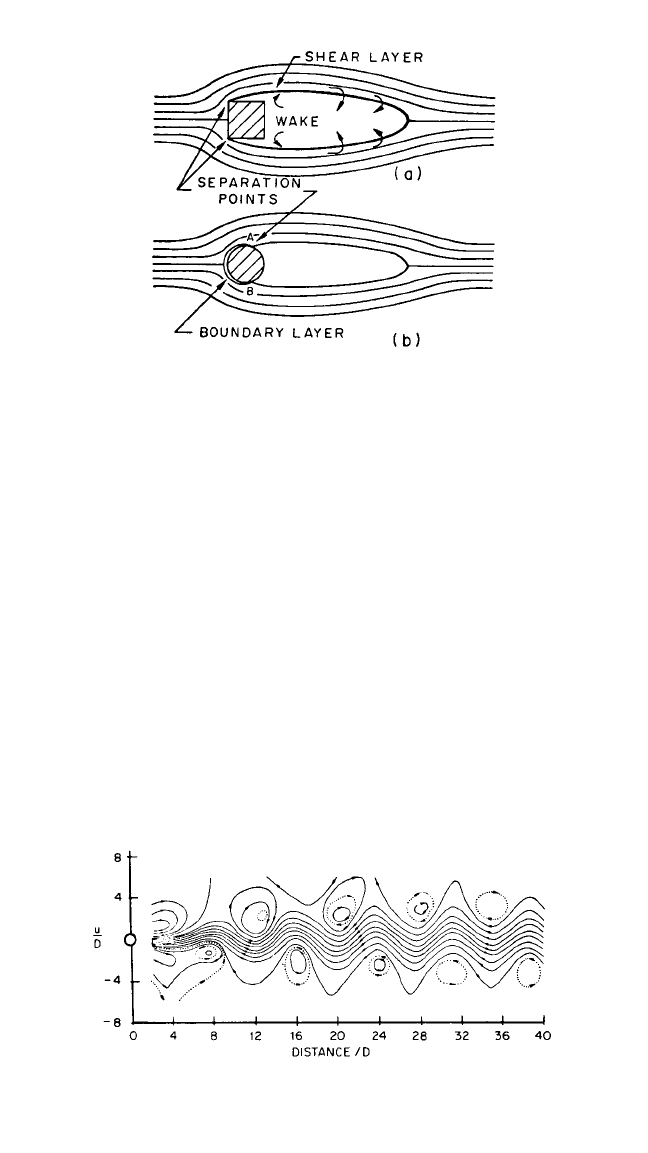
be obtained by averaging the movements of the fluid particles over a time interval
that is long compared with the “transit time” D/V. The instantaneous picture of the
flow may be quite different, as indicated in Fig. 29.16, for two reasons.
First, if the flow is the wind, it is under almost all practical circumstances strongly
turbulent; the oncoming flow will be varying continuously in direction and speed in
an irregular manner. These fluctuating motions will range over a wide range of fre-
quencies and scales (i.e., eddy sizes).
Second, the wake also will take on a fluctuating character. Here, however, the size
of the dominant eddies (vortices) will be of a similar size to the body.The vortices tend
to start off their career by curling up at the separation point and then are carried off
downstream. Sometimes these eddies are fairly regular in character and are shed alter-
nately from either side; if made visible by smoke or other means, they can be seen to
form a more or less regular stepping-stone pattern until they are broken up by the tur-
bulence or dissipate themselves. In a strongly turbulent flow, the regularity is disrupted.
The flow characteristics of the oncoming flow and the wake are the direct causes
of the forces on the bodies responsible for their oscillation. The forms of the result-
ing oscillation are as follows.
1. Turbulence-induced oscillations. Certain types of oscillation of structures can
be attributed almost exclusively to turbulence in the oncoming flow. In the wind these
29.22 CHAPTER TWENTY-NINE, PART II
FIGURE 29.15 Wake formation past bluff bodies:
(a) sharp-edged body; (b) circular cylinder.
FIGURE 29.16 Vortex street past circular cylinder (R = 56). (After
Kovasznay, Proc. Roy. Soc. London, 198, 1949.)
8434_Harris_29_b.qxd 09/20/2001 11:44 AM Page 29.22
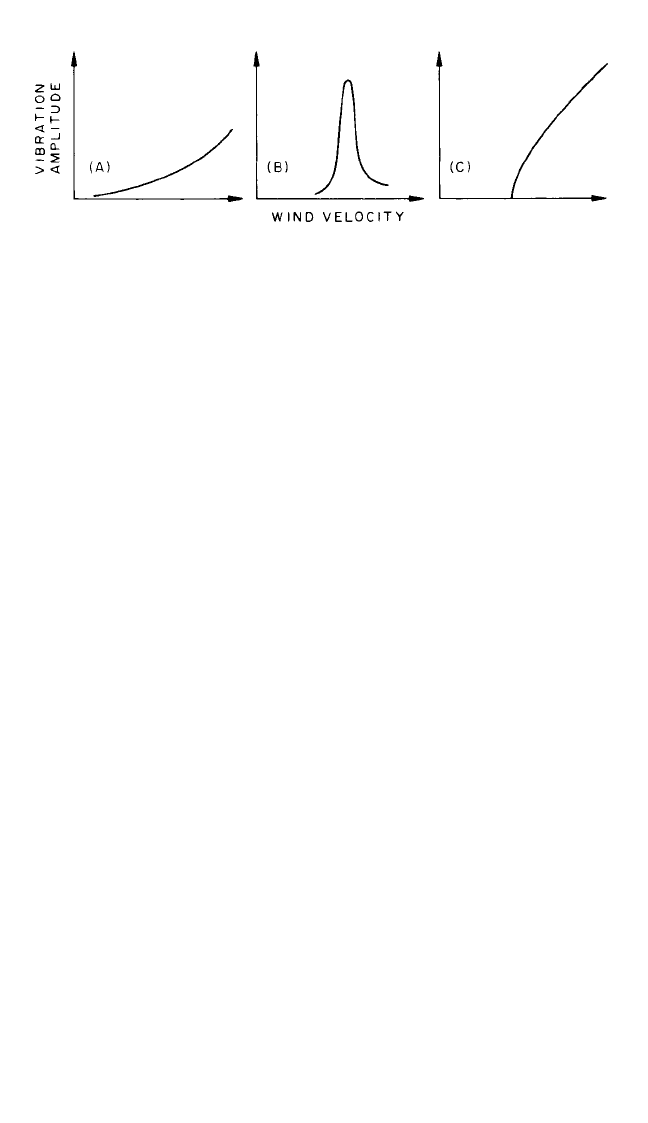
VIBRATION OF STRUCTURES INDUCED BY WIND 29.23
FIGURE 29.17 Main types of wind-induced oscillations: (A) vibration due to turbu-
lence; (B) vibration due to vortex shedding; (C) aerodynamic instability.
may be described as “gust-induced oscillations” (or turbulence-induced, oscillations).
The gusts may cause longitudinal, transverse, or torsional oscillations of the structure,
which increase with wind velocity (Fig. 29.17).
2. Wake-induced oscillations. In other instances, the fluctuations in the wake may
be the predominant agency. Since these fluctuations are generally characterized by
alternating flow, first around one side of the body, then around the other, the most sig-
nificant pressure fluctuations act on the sides of the body in the wake behind the sep-
aration point (the so-called after body); they act mainly laterally or torsionally and to
a much lesser extent longitudinally. The resultant motion is known as vortex-induced
oscillation. Oscillation in the direction perpendicular to that of the wind is the most
important type. It often features a pronounced resonance peak (Fig. 29.17B).
While these distinctions between gust-induced and wake-induced forces are
helpful, they often strongly interact; the presence of free-stream turbulence, for
example, may significantly modify the wake.
3. Buffeting by the wake of an upstream structure. A further type of excitation is
that induced by the wake of an upstream structure (Fig. 29.18). Such an arrangement
of structures produces several effects. The turbulent wake containing strong vortices
shed from the upstream structure can buffet the downstream structure. In addition, if
the oncoming wind is very turbulent, it can cause the wake of the upstream structure
to veer, subjecting the downstream structure successively to the free flow and the
wake flow. This frequently occurs with chimneys in line, as well as with tall buildings.
4. Galloping and flutter mechanisms. The final mechanism for excitation is
associated with the movements of the structure itself. As the structure moves rela-
tive to the flow in response to the forces acting, it changes the flow regime sur-
rounding it. In so doing, the pressures change, and these changes are coupled with
the motion. A pressure change coupled to the velocity (either linearly or nonlin-
early) may be termed an aerodynamic damping term. It may be either positive or
negative. If positive, it adds to the mechanical damping and leads to higher effective
damping and a reduced tendency to vibrate; if negative, it can lead to instability and
large amplitudes of movement. This type of excitation occurs with a wide variety of
rectangular building shapes as well as bridge cross sections and common structural
shapes such as angles and I sections.
In other instances, the coupling may be with either the displacement or accelera-
tion, in which case they are described as either aerodynamic stiffness or mass terms,
the effect of which is to modify the mass or stiffness terms in the equations of
motion. Such modification can lead to changes in the apparent frequency of the
structure. If the aerodynamic stiffness is negative, it can lead to a reduction in the
effective stiffness of the structure and eventually to a form of instability known as
8434_Harris_29_b.qxd 09/20/2001 11:44 AM Page 29.23
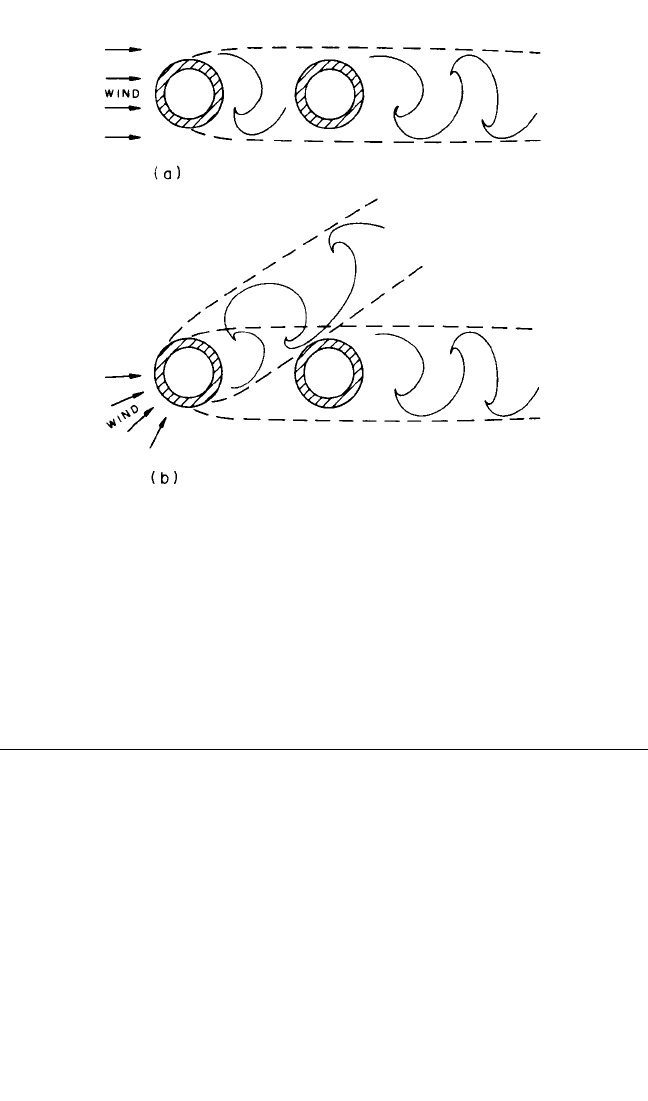
divergence. All types of instability feature a sudden start at a critical wind velocity
and a rapid increase of violent displacements with wind velocity (Fig. 29.17C).
These various forms of excitation are briefly discussed in this chapter. Because all
types of oscillations are influenced strongly by the properties of the wind, some basic
wind characteristics are described first.
BASIC WIND CHARACTERISTICS
Wind is caused by differences in atmospheric pressure. At great altitudes, the air
motion is independent of the roughness of the ground surface and is called the
geostrophic, or gradient wind. Its velocity is reached at a height called gradient
height, which lies between about 1000 and 2000 ft. Below the gradient height, the
flow is affected by surface friction, by the action of which the flow is retarded and
turbulence is generated. In this region, known as the planetary boundary layer, the
three components of wind velocity resemble the traces shown in Fig. 29.19. The lon-
gitudinal component consists of a mean plus an irregular turbulent fluctuation; the
lateral and vertical components consist of similar fluctuations. These turbulent
motions can be characterized in a number of different ways.
The longitudinal motion at height z can be expressed as
V
z
(t) =
¯
V
z
+ v(t) (29.23)
where
¯
V
z
= mean wind velocity (the bar denotes time average) and v(t) = fluctuating
component.
29.24 CHAPTER TWENTY-NINE, PART II
FIGURE 29.18 Buffeting by the wake of an upstream structure.
8434_Harris_29_b.qxd 09/20/2001 11:44 AM Page 29.24
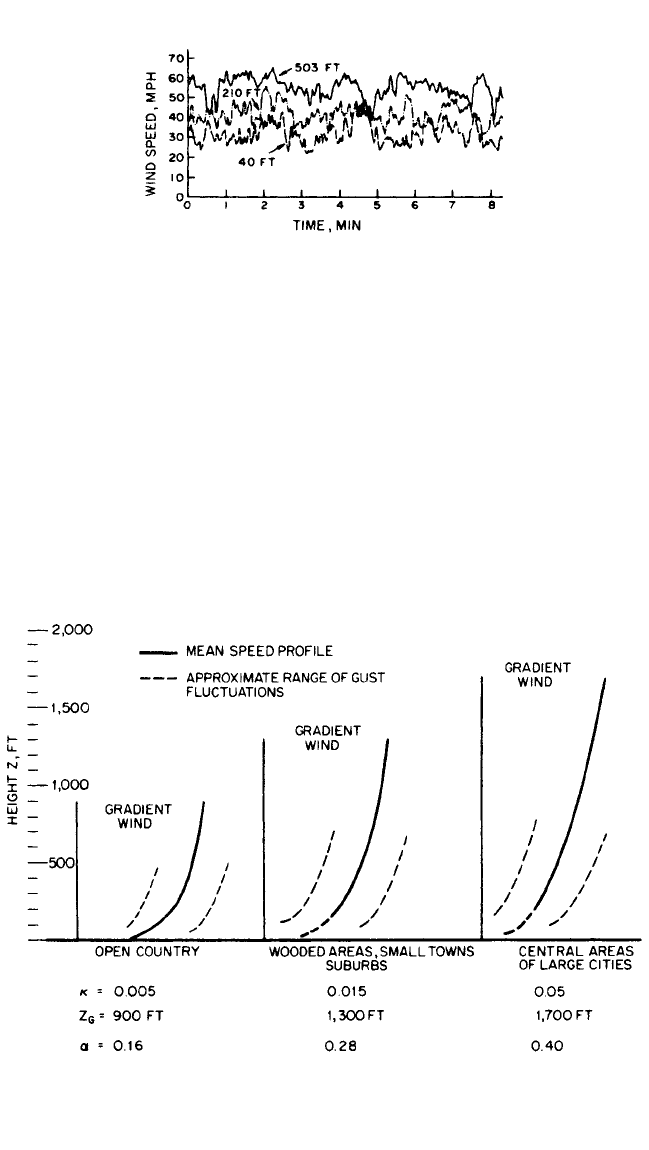
Mean Wind Velocity. The mean wind velocity
¯
V
z
varies with height z as repre-
sented by the mean wind velocity profile (Fig. 29.20). The profiles observed in the
field can be matched by a logarithmic law, for which there are theoretical grounds, or
by an empirical power law
=
α
(29.24)
where
¯
V
G
= gradient wind velocity, z
G
= gradient height, and α=an exponent <1.
Gradient height z
G
and exponent α depend on the surface roughness, which can be
characterized by the surface drag coefficient κ (here referenced to the wind speed at
10 meters).
A few typical values of these parameters are given in Fig. 29.20. The mean wind
profiles shown are characteristic of level terrain. They can significantly change, par-
z
z
G
¯
V
z
¯
V
G
VIBRATION OF STRUCTURES INDUCED BY WIND 29.25
FIGURE 29.19 Record of horizontal component
of wind speed at three heights on 500 ft mast in open
terrain. (Courtesy of E. L. Deacon.)
FIGURE 29.20 Vertical profiles of mean wind velocity for three typical terrains.
8434_Harris_29_b.qxd 09/20/2001 11:44 AM Page 29.25
